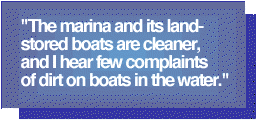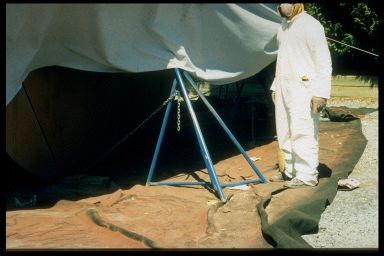
19. Port Annapolis Marina
Screen Tarps Catch Paint Chips/Debris Under Boat Repairs Environmental change
| Location: | 7074 Bembe Beach Road, Annapolis, Maryland 21403-3698 |
| Telephone: | (410) 269-1990; fax: (410) 269-5856 |
| Interviewed: | David Gohsman, General Manager |
| Owned by: | Port Annapolis Marina, Inc. |
| Waterbody: | Back Creek, Chesapeake Bay |
Environmental change
All outdoor boat repair is done over filter screen tarps that screen paint chips and debris from runoff water, resulting in a showplace marina.
The Marina
Port Annapolis Marina is a full-service marina that is a home port for 285 boats kept in slips and another 300 in boatyard storage on land during the summer boating season (total 585). The marina was 94% occupied during the 1995 boating season. Boats kept there are 85% sailboats and 15% powerboats, ranging from 16 feet to 65 feet LOA (average 40 feet). Transient dockage, an important profit center in the Annapolis area, is available. Most customers use the marina year-round. During the boating season there are 16 liveaboards. On a busy weekend, about 15% of the boats are used, with 10% occupied overnight.
Customer amenities include clean restrooms, laundry, pool, and restaurant. The boat services include sail rigging repair, painting, electronic sales/service, new boat sales, brokerage, and pumpout. Boats are launched and hauled with a hydraulic trailer, a crane, and two travel lifts.
Port Annapolis Marina was built in 1965 and acquired by the present owners in 1977. It has 15 full-time employees year-round plus 4 part-timers during the summer. Within a 2-mile radius, there are 4 other marina facilities, all serving a combined population of well over 5,000 boats.
Management measures
Port Annapolis Marina complies with the marina management measures for storm water runoff control and solid waste, as well as water quality assessment, shoreline stabilization, sewage facility, maintenance of sewage facilities, liquid materials, petroleum control, boat cleaning, and public education.
Costs/benefits
During 1995, Port Annapolis Marina spent approximately $2,000 for filter cloth tarps that screen debris and solid waste from water under boats being repaired outdoors. That resulted in clear benefits of increased slip rentals, public recognition, cleaner grounds and water, and fewer flat tires. The marina saves an estimated $3,500 in cleanup costs annually. The cost of the filter cloth was recovered by selling it to each boat being repaired. Less an estimated $1,500 labor cost, Port Annapolis saved an estimated $2,000 by investing in these environmentally sound screen tarps.
Environmental improvements
Since September 1993, Port Annapolis Marina has made major changes in its practices,
which have significantly  reduced
runoff and suspended solids pollution and have made the facility a much cleaner,
nicer place for boaters. With so many boats stored on land during the off-boating
season, a lot of bottom and exterior work is done outdoors by the marina staff, outside
contractors, and do-it-yourself customers.
reduced
runoff and suspended solids pollution and have made the facility a much cleaner,
nicer place for boaters. With so many boats stored on land during the off-boating
season, a lot of bottom and exterior work is done outdoors by the marina staff, outside
contractors, and do-it-yourself customers.
In past years we have had complaints that the marina allowed people to paint their boat or to sand with open sanders, which created drifting dust that covered the ground and nearby boats," said David Gohsman. "Cleanup of boats and autos when no clear responsible party could be found cost the yard over $3,000 in 1993 and was zero in 1995."
"Port Annapolis Marina for several years has required tarps under all boats before being sanded or peeled (usually for removal of a blistered outer gelcoat). We had been using the usual plastic tarps, which did a good job catching the debris. But when it rained heavily, everything flooded and ran off the tarp. I asked my distributor for something which would hold the dust and dirt but let water seep through. He found some nonwoven, needle-punched geotextile-the same filter cloth used under- ground in construction-made by Synthetic Industries. Since September 1994 Port Annapolis has spent $3,000 on tarp purchases." Each 300-foot roll of the nonwoven geotextile filter cloth costs $500, and four rolls were used in 1995 for a total cost of $2,000. "Most of this cost was eventually recovered by charging $1.25 per running foot of the 12-foot-wide geotextile filter cloth."
"The marina and its land-stored boats are cleaner, and I hear fewer complaints of dirt on boats in the water. It cost us up to $1,500 to clean some dirty boats in past years. Estimated boat cleaning cost avoided in 1995 was $3,000 to $4,000. This translated into an estimated $2,000 saving of dollars and less labor to run the marina!"
"The use of tarps has had some positive side effects, such as catching old screws and nails. The marina has almost no flat tires on our autos and on the heavy equipment," Gohsman said. "This has given the boat owner a cleaner pad from which to enter the boat. Less debris underfoot and cleaner ladder rungs also mean we have had fewer falls from boats off ladders, which may be a side benefit."
"We lost some self-service business, which was steered to other marinas by a few marine contractors," stated Gohsman. "But that was more than offset by customers very much happier with our cleaner marina. Generally, there has been no loss of income on environmental supplies sold. They give us increased cooperation with most customers commenting on a cleaner marina. When our public image changed to a marina that tries to 'do the right thing,' this helped increase our slip rental operation."
Other improvements and benefits
Port Annapolis Marina is like many other marinas that are located next to houses and condo developments built after the boating facility. "With us now using tarps, tents, and dustless equipment, these folks are happy and much easier to coexist with," wrote Gohsman.
"We suspended open-air paint spraying weekends since 1994. Spraying during the week must be preauthorized in writing and must be tented to prevent blowing. Tenting off boats is required during painting or heavy sanding/peeling."
"To catch all the dust before it gets into the air or on the ground, we bought three Fein dustless sanders in early 1994 and another three for the 1995 season. They cost us $1,500 each. The dustless sander program is operated at a profit due to rental equipment. Boat owners paid about $1.00 per foot to rent the sanders per day, generating $9,520 rental income in 1995. The equipment-all paid off, still under warranty, and being written off in 3 years-gives us a great profit maker almost as good as our laundry machines!" Gohsman said.
"The usual marina joke in the spring was 'Look at the blue Smurfs.' The boat owners who enjoyed saving money and doing their own bottom (usually blue) in the past came to the ship's store generally covered with blue bottom paint. They often would not wear masks or eye protection. Now they are eager to emulate the marina worker who is in a white paper suit and is using a dustless sanding rig with full face protection."
"To control outside contractors, we established an environmental agreement that must be signed by each marine contractor who wants to work in the yard," Gohsman explained. "This agreement with the marina has had strong side effects and some push back. We have stood our ground and the number of contractors in the yard has dropped from about 95 to 48. Many of the 47 who went elsewhere, with 2 or 3 exceptions, were marginal workers doing business out of older vans or pickups. This may have cost us some business, but there is no real way to tell with the recession [1989-1993] having the effect it did on customers."
Port Annapolis Marina also lost 45 boat customers when the environmental agreement went into effect, "but these were customers who were not as interested in a clean marina as those who stayed, and we soon rented those slips to new customers," Gohsman said with a smile. "I suspect that the cleaner environment has an attraction and the example of tents and dustless equipment is contagious. Cars and windows are visibly cleaner."
Other environmental improvements include installing a pumpout station in 1988 with a grant from the State of Maryland. The pumpout cost $2,500. The service is free for slip customers and $2.00 for others, and the marina did 309 pumpouts in 1995. The pumpout is located on a pier T-head and is operated by marina staff.
Port Annapolis Marina has a designated hull work area in the boatyard away from the water. It has filters and traps to control solids from the hull pressure wash area. There is oil spill cleanup equipment kept handy in the storage area near the lift well. Recycling is done for cans, bottles, batteries, and used oil.
"Local and federal regulators come here as if we were a 'showplace' and bring
others for a look," said Gohsman. "Chesapeake Bay magazine, based on customer
polls, gave Port Annapolis Marina the 'Best Repair Yard in Annapolis' Award in both
1994 and 1995."
| Port Annapolis Marina places a reusable filter cloth beneath boats under repair. (photo by Port Annapolis Marina). |
 |
Equipment source
- Filter cloth, heavyweight geotextile: #701 nonwoven, needle-punched geotextile; Synthetic Industries, Inc., 4019 Industry Drive, Chattanooga, TN 37416.
http://www.epa.gov/owow/NPS/marinas/ch19.html
This page last updated October 4, 1999


